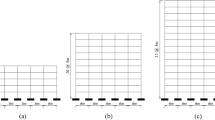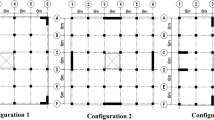Abstract
Performance-based design establishes performance objectives in terms of earthquake intensities. Damage limit states depend on the building demands in the nonlinear range of behavior when subjecting the structure to a suite of seismic records. Most of world databases have strong-motions recorded from small- and moderate-magnitude earthquakes that need to be scaled when studying the expected building performance under maximum considered earthquake. Scaling accelerograms is a frequent activity in nonlinear analysis of structures, and different techniques based on several intensity measures have been used, without a general consensus to select the most appropriate scaling methodology. This study shows the variability in the seismic performance assessment of reinforced concrete buildings of different heights, symmetrical in plan and regular in elevation, on four seismic zones, when using scaled accelerograms for a maximum considered earthquake, assumed for a return period of Tr = 2500 years. Ten methodologies frequently used in the literature are analyzed to evaluate inter-story drift ratio and floor acceleration demands of buildings subjected to a suite of near-, medium- and far-fault interplate earthquakes. The results show different expected damage limit states as a function of the scaling technique used. Additionally, some scaling techniques consistently generate higher seismic demands regardless of the seismic location of the buildings, whereas another group produces quite similar demands. Moreover, a building could be placed in the slight damage limit state or in a zone of extensive damage depending on the scaling technique used.

























Similar content being viewed by others
References
Avsar Ö, Yakut A, Caner A (2011) Analytical fragility curves for ordinary highway bridges in Turkey. Earthq Spectra 27:971–996
Baker JW, Cornell CA (2005) A vector-valued ground motion intensity measure consisting of spectral acceleration and epsilon. Earthq Eng Struct Dynam 34:1193–1217
CSI (2015a) SAP2000. Computer and Structures Inc., Berkeley, CA
CSI (2015b) PERFORM 3D. Computer and Structures Inc., Berkeley, CA
Davatgari-Tafreshi M, Bora SS (2023) Empirical ground-motion models (GMMs) and associated correlations for cumulative absolute velocity, Arias Intensity, and significant durations calibrated on Iranian strong motion database. Bull Earthq Eng 21:4139–4166
Dehghanpoor A, Thambiratnam D, Zhang W, Chan T, Taciroglu E (2021) An extended probabilistic demand model with optimal intensity measures for performance characterization of isolated bridges under coupled horizontal and vertical motions. Bull Earthq Eng 19(5):2291–2323
Ebrahimian H, Jalayer F, Lucchini A, Mollaioli F, Manfredi G (2015) Preliminary ranking of alternative scalar and vector intensity measures of ground shaking. Bull Earthq Eng 13(10):2805–2840
Gulerce Z, Erduran E, Kunnath SK, Abrahamson NA (2012) Seismic demand models for probabilistic risk analysis of near fault vertical ground motion effects on ordinary highway bridges. Earthq Eng Struct Dynam 41:159–175
Ha SJ, Han WH (2016) An efficient method for selecting and scaling ground motions matching target response spectrum mean and variance. Short Commun Earthq Eng Struct Dyn 48(8):1–7. https://doi.org/10.1002/eqe.2702
Hasanoğlu S, Güllü E, Güllü A (2023) Empirical correlations of constant ductility seismic input and hysteretic energies with conventional intensity measures. Bull Earthq Eng 21:4905–4922. https://doi.org/10.1007/s10518-023-01722-x
Hazus 5.1 (2022) Hazus earthquake model technical manual. Federal Emergency Management Agency, Washington DC
II (2018) Database of seismic records RAII-UNAM. Institute of Engineering, México. https://aplicaciones.iingen.unam.mx/AcelerogramasRSM/ RedAcelerografica.aspx
Jara JM, Hernández EJ, Olmos BA (2021) Effect of epicentral distance on the applicability of base isolation and energy dissipation systems to improve seismic behavior of RC buildings. Eng Struct 230:1–15
Jin-Hai H, Yu-Tao P, Xinzhi D, Wan-Cheng Y (2021) Investigation of the relationship between intensity measures and engineering demand parameters of cable-stayed bridges using intra-plate earthquakes. Eng Comput 38(4):1920–1932
Kalateh-Ahani M, Amiri S (2021) A Park-Ang damage index-based framework for post-mainshock structural safety assessment. Structures 33:820–829
Kim SH, Feng MQ (2003) Fragility analysis of bridges under ground motion with spatial variation. Non-Linear Mechanics 38:705–721
Kurama YC, Farrow KT (2003) Ground motion scaling methods for different site conditions and structure characteristics. Earthq Eng Struct Dynam 32:2425–2450
Lee KH, Rosowsky DV (2006) Fragility analysis of wood frame buildings considering combined snow and earthquake loading. Struct Saf 28:289–303
Mackie K, Stojadinovic B (2001) Probabilistic seismic demand model for California highway bridges. J Bridge Eng 6(6):468–481
Mander JB, Priestley MJ, Park R (1998) Theoretical stress-strain model for confined concrete. J Struct Div ASCE 144(8):1804–1826
MOC (2015) Design Manual for Civil Works, Seismic Design. Electrical Research Institute (IIE), México
NTC (2017) Complementary Technical Standards. Criteria and Actions for the Structural Design of Buildings in Mexico City, Diario Oficial de la Federación, December, 2017 (in Spanish)
Padgett JE, Nielson BG, DesRoches R (2008) Selection of optimal intensity measures in probabilistic seismic demand models of highway bridge portfolios. Earthq Eng Struct Dyn 37(5):711–725
Papazafeiropoulos G, Plevris V (2023) Kahramanmaras-Gaziantep, Turkiye Mw 7.8 Earthquake on February 6, 2023: Preliminary Report on Strong Ground Motion and Building Response Estimations. arXiv:2302.13088 [physics.geo-ph]
Park R, Paulay T (1975) In reinforced concrete structures, 1st edn. John Wiley & Sons, USA, pp 36–45
Rahgozar N, Pouraminian M, Rahgozar N (2021) Reliability-based seismic assessment of controlled rocking steel cores. J Build Eng 44:102623
Shinozuka M, Kim SH, Kushiyama S, Yi JH (2002) Fragility curves of concrete bridges retrofitted by column jacketing. Earthq Eng Eng Vib 1(2):195–205
Shome N, Cornell C, Bazurro P, Carballo J (1998) Earthquakes, records, and nonlinear responses. Earthq Spectra 14:469–500
SMIS (2000) Mexican Earthquake Database, Sociedad Mexicana de Ingeniería Sísmica, CD-ROM, 2000
Tondini N, Stojadinovic B (2012) Probabilistic seismic demand model for curved reinforced concrete bridges. Bull Earthq Eng 10:1455–1479
Tothong P, Luco N (2007) Probabilistic seismic demand analysis using advanced ground motion intensity measures. Eng Comput 38(4):1920–1932
Vargas-Alzate YF, Hurtado JE, Pujades LG (2022) New insights into the relationship between seismic intensity measures and nonlinear structural response. Bull Earthq Eng 20(5):2329–2365
Vidic T, Fajfar P, Fischinger M (1994) Consistent inelastic design spectra: strength and displacement. Earthq Eng Struct Dyn 23:507–521
Xian-Liang R, Yang J-H, Jun L, Zhang Y-X, Zheng SS, Dong L (2023) Optimal ground motion intensity measure for seismic assessment of high-rise reinforced concrete structures. Case Stud Constr Mater 18:e101678
Yin YJ, Li Y (2011) Probabilistic loss assessment of light-frame wood construction subjected to combined seismic and snow loads. Eng Struct 33:380–390
Author information
Authors and Affiliations
Corresponding author
Additional information
Publisher's Note
Springer Nature remains neutral with regard to jurisdictional claims in published maps and institutional affiliations.
Rights and permissions
Springer Nature or its licensor (e.g. a society or other partner) holds exclusive rights to this article under a publishing agreement with the author(s) or other rightsholder(s); author self-archiving of the accepted manuscript version of this article is solely governed by the terms of such publishing agreement and applicable law.
About this article
Cite this article
Jara, J.M., Olmos, B.A., Tinajero, A. et al. Influence of the scaling technique and seismic location on the dynamic response of reinforced concrete buildings subjected to a maximum considered earthquake. Bull Earthquake Eng 22, 2981–3009 (2024). https://doi.org/10.1007/s10518-024-01903-2
Received:
Accepted:
Published:
Issue Date:
DOI: https://doi.org/10.1007/s10518-024-01903-2




